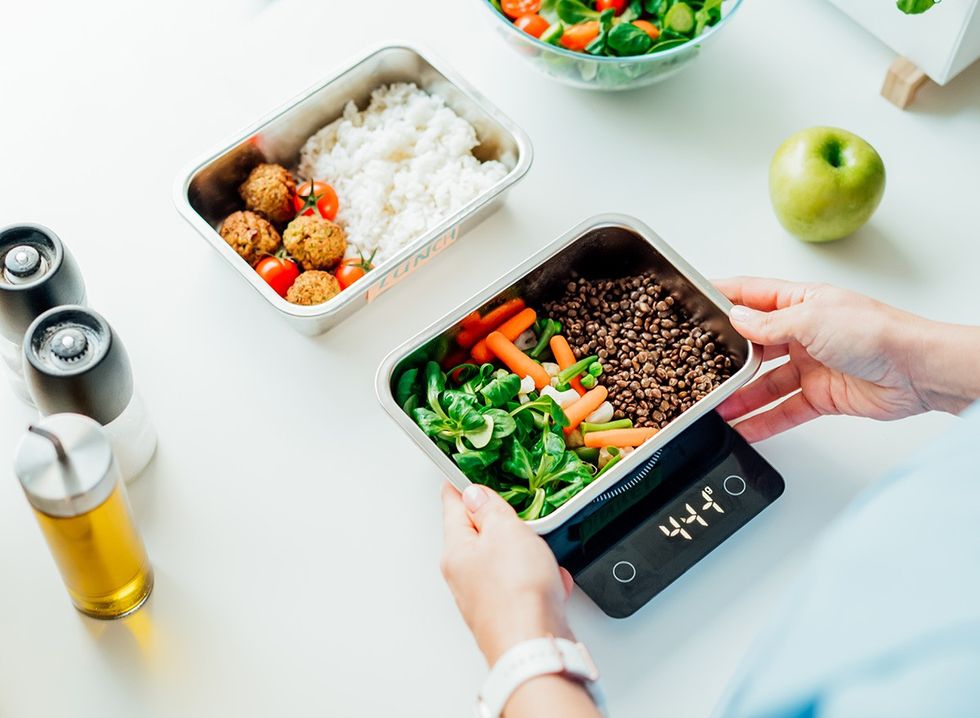Have you ever scrolled through social media and wondered if you could take on a fitness challenge? YouTube influencer Susie J. Todd did just that when she stumbled upon a TikTok video of someone doing 45 minutes on the Stairmaster daily. Inspired, Susie decided to embark on her own 14-day Stairmaster challenge, committing to 30 minutes every day. Keep reading to learn about her experience and simple expert tips to kickstart your challenge.
What Is the Stairmaster?
Before diving into Susie's experience, let's understand what the Stairmaster is and its benefits. Stephen Sheehan, CPT, CNC from Garage Gym Reviews, explains: "The Stairmaster is a no-nonsense cardio machine that mimics the action of climbing stairs by using a set of rotating steps. This provides a high-intensity, low-impact workout that mostly engages your lower body and core."
RELATED: 6 Signs Your Body Needs More Nutrients
The Challenge Begins
Susie started her journey with some trepidation. "I don't think I've ever even done five minutes on the Stairmaster before, so I'm kind of scared," she confessed on day one, in her video. Despite her initial fears, Susie pushed through, gripping the sides for support and discovering that the Stairmaster "literally shifts time itself."
Pushing Through the Pain
As the days progressed, Susie faced various obstacles. She dealt with asthma, back pain, and the mental challenge of showing up every day. "You can't rely on motivation all the time. Sometimes you have to rely on discipline," Susie reflected in her video. She found that the hardest days to show up were often the most important.
Benefits of the Stairmaster
Sheehan highlights several key benefits of incorporating the Stairmaster into your workout routine:
Calorie Burning:
"According to the American Council on Exercise (ACE) physical activity calorie counter, a 190-pound person can burn about 344 calories in 30 minutes of stair climbing," Sheehan notes.
Cardiovascular Health:
"A 2024 study found that stair climbing improves aerobic capacity and serum biomarkers by between 9% and 15%," Sheehan explains. "Regular stair climbing for at least four to eight weeks can improve cardio-metabolic risk indicators such as body composition, blood pressure, cholesterol levels, and insulin sensitivity."
Core Engagement:
Sheehan points out, "Your rectus abdominis, obliques, and erector spinae must all remain engaged throughout the workout to support your spine."
Lower Body Strength: "All of your major lower-body muscle groups are heavily involved in step climbing, especially your glutes," says Sheehan.
Unexpected Benefits
Despite the physical challenges, Susie began to notice improvements in her fitness and mood. "I lowkey feel like I'm getting fitter though already and it's only been four days," she remarked. The routine also had a positive impact on her mental health, with Susie noting in her video, "Movement is the best medicine."
RELATED: 12 Expert Tips to Shed 10 Pounds Before the Holidays
Overcoming Obstacles
Throughout the challenge, Susie faced several hurdles. From dealing with gym etiquette to fighting fatigue, she persevered. "I think Sports Illustrated should hire me as a cover model because I am an elite athlete," she joked after a particularly tough session.
The Final Stretch
As the challenge neared its end, Susie reflected on her progress. "I really didn't think I was going to be able to finish that one for a second," she admitted on day 13. However, she pushed through, reminding herself and her audience that "your only competition is yourself."
RELATED: 10 Natural Ways to Lower Stress Levels Now
The Results
After 14 days, Susie completed her challenge with a sense of pride and accomplishment. "I actually feel so much fitter and amazing though and so accomplished," she shared in her video. While she noticed physical changes like reduced bloating, the mental benefits were equally significant.
Lessons Learned
Susie's experience taught her valuable lessons about consistency and self-belief. "I really push myself and I'm so proud for getting through it," she reflected. However, she also cautioned against overdoing it, noting, "I do not recommend doing the Stairmaster every single day because you need rest days."
Moving Forward
While Susie doesn't plan to continue daily Stairmaster sessions, the challenge changed her perspective. "It's not my enemy anymore," she said of the machine. She plans to incorporate it into her routine a couple of times a week, balancing intensity with proper rest.
RELATED: I Shed 20 Pounds Using This 3-Step System (And Kept It Off for 8 Years)
Tips for Beginners
For those inspired by Susie's journey and looking to start their own Stairmaster challenge, Sheehan offers these tips:
Start with a Warm-Up:
"Before you climb on the Stairmaster, perform a series of dynamic and static stretches to open up your hips, quads, hamstrings, and glutes," Sheehan advises.
Maintain Proper Form:
"Engage your core and keep an upright posture, either holding onto the handrails or moving your arms naturally as you would while walking or climbing stairs," says Sheehan.
Incorporate Interval Training:
Sheehan suggests, "Swap out low-and-slow steady-state sessions for HIIT workouts. Alternating between periods of high intensity and rest/active recovery will challenge both your aerobic and anaerobic capacity."
Use a Heart Rate Monitor:
"Aim for 80% to 90% of your maximum heart rate (MHR) for high-intensity intervals and about 60% to 80% for moderate-intensity workouts," Sheehan recommends.
Cool Down:
"Take at least five to 10 minutes to let your heart rate return to normal," advises Sheehan.
And if you enjoyed this article, don't miss 12-3-30 Walking Method: 20 Proven Tips to Lose Weight Faster.

















 kikivirk/TikTok
kikivirk/TikTok Shutterstock
Shutterstock Shutterstock
Shutterstock Shutterstock
Shutterstock hitfitnesstraining/Instagram
hitfitnesstraining/Instagram
 Morgan Green/YouTube
Morgan Green/YouTube Morgan Green/YouTube
Morgan Green/YouTube Shutterstock
Shutterstock Morgan Green/YouTube
Morgan Green/YouTube Morgan Green/YouTube
Morgan Green/YouTube Morgan Green/YouTube
Morgan Green/YouTube Morgan Green/YouTube
Morgan Green/YouTube Shutterstock
Shutterstock Morgan Green/YouTube
Morgan Green/YouTube Morgan Green/YouTube
Morgan Green/YouTube Morgan Green/YouTube
Morgan Green/YouTube Shutterstock
Shutterstock Morgan Green/YouTube
Morgan Green/YouTube Morgan Green/YouTube
Morgan Green/YouTube Shutterstock
Shutterstock

 I'm a Nutritionist and These 9 High-Protein Snacks Keep My Clients Full While Losing 50 Pounds
I'm a Nutritionist and These 9 High-Protein Snacks Keep My Clients Full While Losing 50 Pounds
 Shutterstock
Shutterstock 2. Processed FoodsShutterstock
2. Processed FoodsShutterstock Shutterstock
Shutterstock Shutterstock/Prostock-studio
Shutterstock/Prostock-studio Shutterstock
Shutterstock Pro TipsShutterstock
Pro TipsShutterstock Shutterstock
Shutterstock Shutterstock
Shutterstock Shutterstock
Shutterstock Shutterstock
Shutterstock Don’t Drink as Much AlcoholShutterstock
Don’t Drink as Much AlcoholShutterstock Most Women on GLP-1s Are Making a Few Common MistakesShutterstock
Most Women on GLP-1s Are Making a Few Common MistakesShutterstock Soda and Sugary DrinksShutterstock
Soda and Sugary DrinksShutterstock Shutterstock
Shutterstock Eat BreakfastShutterstock
Eat BreakfastShutterstock And Improve Insulin SensitivityShutterstock
And Improve Insulin SensitivityShutterstock Belly Flab Strip Tip: Sugar and Fat Calories Leave Its Mark on Your BodyShutterstock
Belly Flab Strip Tip: Sugar and Fat Calories Leave Its Mark on Your BodyShutterstock Shutterstock
Shutterstock The Drugs Mimic the GLP-1 Hormone Naturally Produced by the BodyShutterstock
The Drugs Mimic the GLP-1 Hormone Naturally Produced by the BodyShutterstock 3. Deep-Fried ItemsShutterstock
3. Deep-Fried ItemsShutterstock